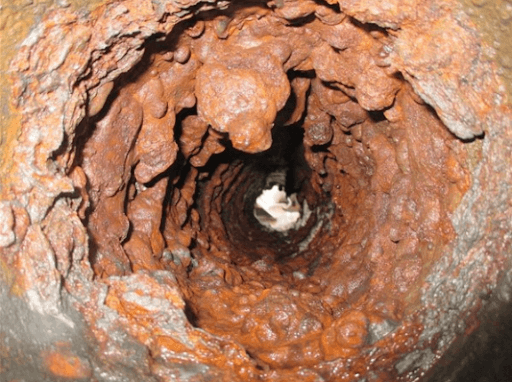What Does
Tuberculation Mean?
Tuberculation is the formation of mounds of reddish-brown iron-oxide on a pipe’s interior. This phenomenon is classified as a type of bacteria-driven corrosion and is typically associated with older iron pipes. Tuberculation is caused by the action of microorganisms in the pipe medium. Bacteria in the pipe feed on iron and manganese in the water, resulting in the deposit and accumulation of iron/manganese by-products on the pipe’s inner walls.
Tuberculation usually starts as a thin film of slime (known as biomass). This biomass houses thousands of iron- and manganese-hungry bacteria that metabolize ferrous ions contained in the water. This metabolism process produces ferrous oxides that accumulate in the biomass film. If left untreated, this metabolic process continues unabated, forming mounds of oxide inside the pipe.
Excessive tuberculation can have several adverse effects on the pipe as well as the water quality delivered to end customers. Ferrous oxide accumulation eventually reduces the pipe’s effective internal diameter, which lessens its flow capacity. This can lead to several hydraulic issues, such as low flow rates, increased pressure buildup in pipes, and even damaged pumping equipment.
For customers, tuberculation can result in reddish-brown discoloration of water coming out of pipes. Staining of plumbing fixtures, odor and taste irregularities, and damaged appliances, are just some of the adverse effects of tuberculation.
Trenchlesspedia Explains Tuberculation

Figure 1: Tuberculation inside a cast iron pipe (source)
Tuberculation is typically associated with iron pipes manufactured before the 1940s. However, these older pipes remain a crucial part of the water distribution system in many municipalities. Because it takes time to accumulate, consumers only began to feel the effects of tuberculation at the turn of the 21st century.
Preventing Tuberculation in Metal Pipes
The advent of cement-based mortar and the development of cementitious lining standards have significantly minimized the occurrence of this bacteria-based corrosion. Cement-mortar linings prevent tuberculation by forming a physical barrier between the water and the pipe. Since the water does not come into contact with the pipe, the iron-oxide reaction is eliminated.
How Is Tuberculation Removed From Pipes?
One of the most effective ways to remove tuberculation from iron pipes is Unidirectional Flushing (UDF). This cleaning method involves directing high-velocity water in a single direction through the pipeline. UDF is highly effective in removing biomass, ferrous oxide buildup, debris, and other unwanted material from inside the pipe. This cleaning method ultimately enhances water quality, reduces turbidity, and improves chlorine residual.
One of the main advantages of UDF is its ability to deliver a significant amount of water pressure through a single targeted pipeline. During conventional flushing, multiples pipes are flushed simultaneously, resulting in a haphazard flushing system that does not produce the desired water pressure needed to remove tuberculation.